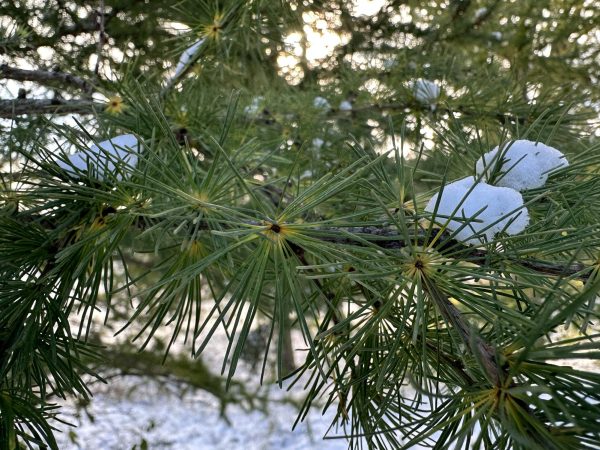Photo caption: Tamaracks, a deciduous species native further north, begin to lose their needles for the season during the October snow. Photo by Klara Kjome Fischer ’26.
The first snow has come and gone, the last of the color is falling from the trees and the change in season is apparent. Plants and animals alike are making preparations for the coming cold. It’s time to bundle up and see who’s out and about!
Deer here? Signs of deer are everywhere. They will overwinter here, eating the buds of trees and shrubs. It is actually the beginning of mating season for them!
Underground retreat: Many small plants die back to ground, where they survive the winter as seeds, roots, or buds.
Who’s cold? Ectotherms like snakes, frogs and turtles that don’t make their own body heat must bury deep in soil or water to keep from freezing over the winter — though some frogs can survive freezing solid! Most will stay inactive until spring.
FUNGI! It’s the perfect time of year for many fungi in the Arb. Recent storms have left the ground damp, and fungi are putting out their spores. They will overwinter in different ways: in spores and by producing antifreeze, according to the US Forest Service.
“It’s not easy bein’ green…” Evergreens still photosynthesize through winter, but may dry out when the soil freezes. Deciduous trees, in contrast, go dormant, dropping their leaves. They keep their cells from freezing by flushing out water and saturating them with sugars, and buds are protected through winter to leaf out as soon as possible (Purdue University).
Flakes and feathers: Some birds migrate to avoid the snow, while others stay here through the winter. Check out last year’s Arb Notes to learn more!
Snug as a bug in a rug: some worms cover themselves in slime and burrow underground below the frost line. Other insects migrate to warmer climates or overwinter in different stages of their life cycles, as noted by the University of Minnesota.
So, as you prepare your slime coat, get out there and see how others are enjoying the changing season!












